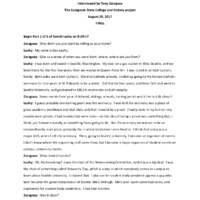Daniel Leahy Oral History Interview
Item
- Identifier
- Title
- Date
- Creator
- Contributor
-
LeahyDaniel
-
Daniel Leahy Oral History Interview
-
August 29, 2017
-
August 30, 2017
-
Daniel Leahy
-
Anthony Zaragoza
Position: 509 (10 views)

